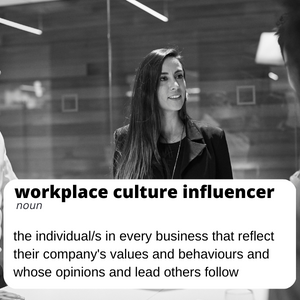 Workplace culture has always been a key element to an organisation’s success or failure – just compare the supportive and forward-thinking Apple to the oppressive and abrasive Enron. But with the concept of work having changed significantly and people’s priorities having shifted dramatically over the past few years, a strong internal culture has never been so important.
Workplace culture has always been a key element to an organisation’s success or failure – just compare the supportive and forward-thinking Apple to the oppressive and abrasive Enron. But with the concept of work having changed significantly and people’s priorities having shifted dramatically over the past few years, a strong internal culture has never been so important.
But culture isn’t something that is created at the top of the organisational chart. Instead, it’s formation and perpetuation is a shared responsibility held at all levels of the business. Some team members just happen to exert a greater influence in shaping the internal culture than others. And organisations of all sizes need to be aware of these people and learn to use their influence as a force for good.
Culture Influencers
Whilst culture is formed organically, this does not mean that there can’t be an element of intentional design and effort to shape it in the right direction. Business leaders simply need to recognise the role they must play, as well as the impact other influential individuals across the team have, on driving the culture that best suits the organisation in question.
Throughout every workplace, culture influencers are operating in plain sight. Often the heartbeat of an organisation, the eyes and ears of what’s going on at every level. Great communicators with strong people skills, who model the business values and behaviours.
Often more influential than the SLT, people value their opinions, trust the information they share and often follow their lead.

We don’t live and work in a vacuum. The business landscape is constantly changing and evolving, and this is reflected within the internal fabric of a company. Post-pandemic, leaders have had to reconsider how to engage, motivate and manage individuals who no longer have a daily physical presence in the office, balanced against the needs of those who are still coming into their actual workplace.
Employers therefore need to engage hybrid teams and cultivate an environment where employees feel empowered, and their work-life balance is protected and valued.
In the modern workplace how culture is developed and shaped must therefore be seen as the shared responsibility of all stakeholders within an organisation. However, there are some individuals who hold more cultural cachet and persuasive sway over the team than others – many of whom outside of leadership and who don’t hold a title of authority. It is therefore imperative that leaders identify and engage with these individuals and give them the resources and support to engender the right culture through their words, actions and attitudes.
Recognising culture influencers
Cultural influencers tend to be easy to recognise. They garner an exemplary reputation for actively promoting a positive workplace and demonstrate continuous support for both their colleagues, and their company’s mission and values. They find ways to recognise their colleagues and their contributions, and they collaborate with others in an outcome-orientated way:
In other words, they walk the walk and talk the talk.
Influencers exhibit authenticity and passion without being pushy. They understand that change must happen, but they don’t try and force this through quickly with a narrow-sighted, blunt approach. Cultural influencers or champions are superb listeners, excellent communicators and adept persuaders. Without being asked to, these people automatically invest in activities that involve their colleagues and push the business forward.

Nurturing and shaping existing culture
Culture isn’t static. Regardless of the prevailing culture, individuals and collective effort can still work to develop and shape the internal concept of ‘who we are and how things work around here’. Leaders have a role to play here too. Not by forcing a synthetic culture, but rather by understanding what the current reality is, recognising which brand values and behaviours inform it, and identifying exactly what they would like the internal make-up of the organisation to look and feel like in the future. A leader’s role is then to communicate this, role model the behaviours, and then trust and encourage others to bring this into actuality.
Create a steering group
One way to encourage culture influencers within the organisation is to create a culture steering group. Comprised of a cross-spectrum of people from the organisation who reflect the brand and the values of the business, this group can assess the gaps within the business, highlight the areas where culture is evident, and where it needs attention, and then take steps to plug any gaps. Facilitating a space for such influencers to set up activities ensures that everyone is engaged and involved, and it encourages greater buy-in to the organisation. Developing situations and environments where culture can breathe is an important step in retaining talent and building a people-first culture. Leaders must therefore nurture influencers by having them shape their own activities and then hold them accountable for the outcomes, ensuring that feedback highlights how such efforts support the goals and aims of the business.
A cultural influencer is an individual who is committed to supporting the overall goals of an organisation, and who understands the need to lead change. Leaders can nurture them by giving them the freedom they need to make an impact, and to create opportunities for them to engage with their colleagues.
By providing the opportunities, encouragement and support to become more visible and vocal, and creating an environment that allows them to feel empowered and engaged, cultural influencers will do exactly what they do best – influence culture in a profoundly positive way.
Corporate culture is complex, and a healthy one is key to winning in a competitive marketplace. In a hybrid working world, culture now needs to evolve to reach and engage dispersed workforces. Whilst culture starts at the top and begins with the behaviours of senior leaders in many instances, organisations must also recognise the importance of building a people-first culture. It is thus imperative that cultural influencers are found at every level of the organisation; champions share the company’s vision and behaviours, and who will proliferate their brand affection and loyalty to others. Cultural influencers help drive change, deliver key messages, and provide feedback to the Senior Leadership Team when things aren’t working.
Like corporate culture itself, culture influencers need to be deliberately tended to and nurtured, they will in turn create a constructive, consistent, and collegial atmosphere that can weather any storm. Whilst leaders may steer the ship, culture influencers and champions keep it rowing in motion.
Useful resources:
Engaging and Retaining Empowered Employees
Transforming Attitudes and Actions: How Senior Leaders Create Successful Workplace Cultures

